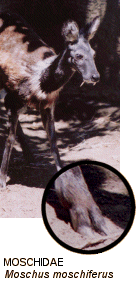 |
The musk deer were formerly treated as a Cervid subfamily ("Moschinae"),
but this group is now generally recognized as a family in its own right.
The taxonomy of this family is under constant review - where once all musk
deer were considered to be a single species (Moschus moschiferus),
today at least nine distinct species have been described, of which seven
are recognized here. Musk deer are entirely Asian in their present distribution,
although the earliest musk deer are known from Oligocene deposits in Europe.
The Moschidae never bear horns or antlers, and possess a gall bladder; in these ways they resemble oversized chevrotains (Tragulidae) rather than true deer (Cervidae). Seemingly to compensate for their lack of headgear, the upper canines of males form long (up to 10 cm) downward-pointing tusks. The dental formula is I 0/3, C 1/1, P 3/3, M 3/3 x 2 = 34. Musk deer are well-adapted to a leaping form of locomotion: the hind legs are nearly one-third longer than the forelimbs and the back is curved, raising the hindquarters well above the shoulders and giving musk deer a posture which is primed for fleeing at the slightest hint of danger. Musk deer are extremely agile, able to bound long distances easily and turn on a dime. The dewclaws are well-developed, increasing stability on steep slopes and uneven terrain. Adult males of all musk deer species possess a gland in their abdomen which secrets a pungent, waxy substance called musk - hence the common name "musk deer". This musk has been highly prized as a base for perfumes, soaps, and medicinal preparations. Because of its varied uses, special properties, and rareness, musk is reputed to be the most expensive animal product available, valued at up to $45,000 (USD) per kilogram. Approximately 28 grams of musk can be obtained from a single musk gland - while the musk can be extracted from live animals, musk deer (including females and juveniles, which do not have musk glands) are typically caught and killed in snares. As a result of extensive hunting, populations of all musk deer species have dropped rapidly; all are listed in CITES Appendices I and II. Farming operations in China are now being used to reduce the pressure on wild populations. |
(From Su, Wang, and Wang, 2001)
| Return to Artiodactyla |
Moschus moschiferus
Moschus anhuiensis Moschus berezovskii Moschus fuscus Moschus cupreus Moschus leucogaster |
or jump to the Moschidae Species List